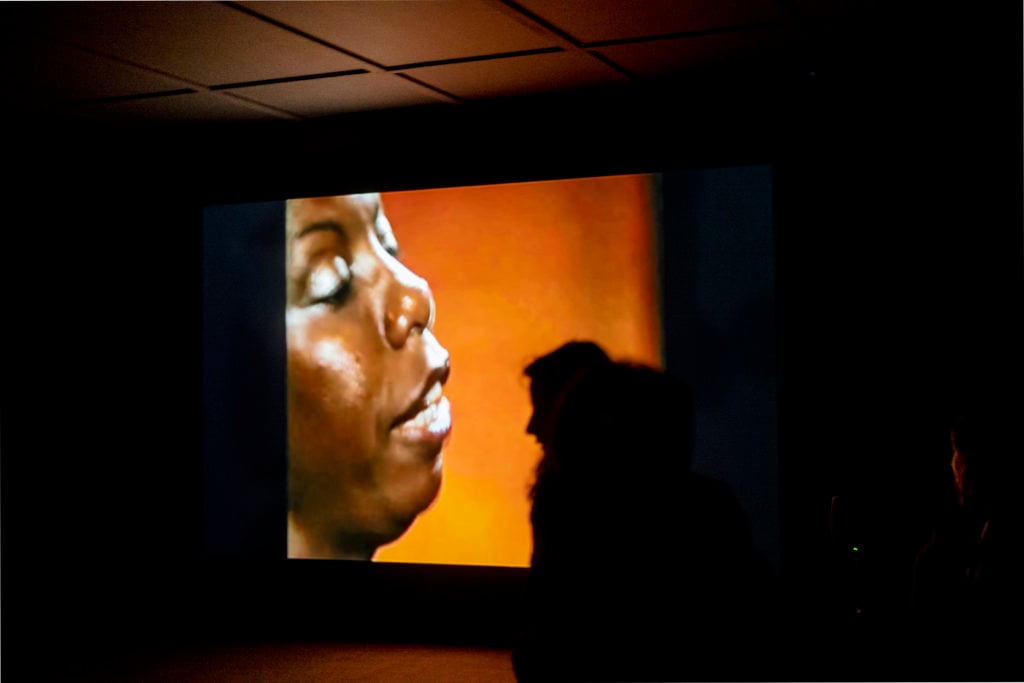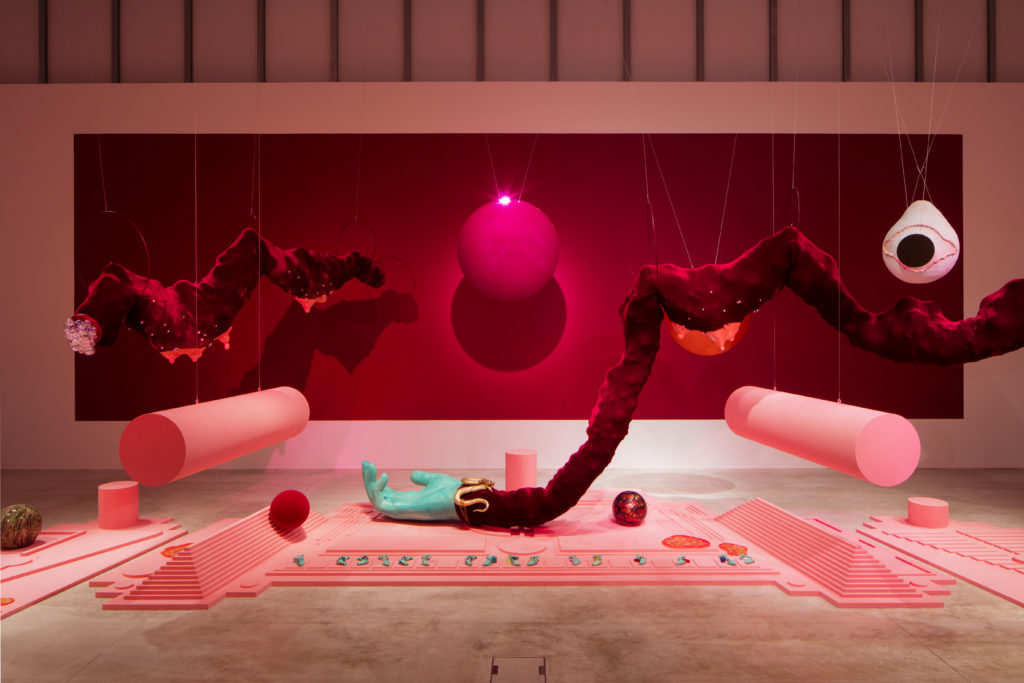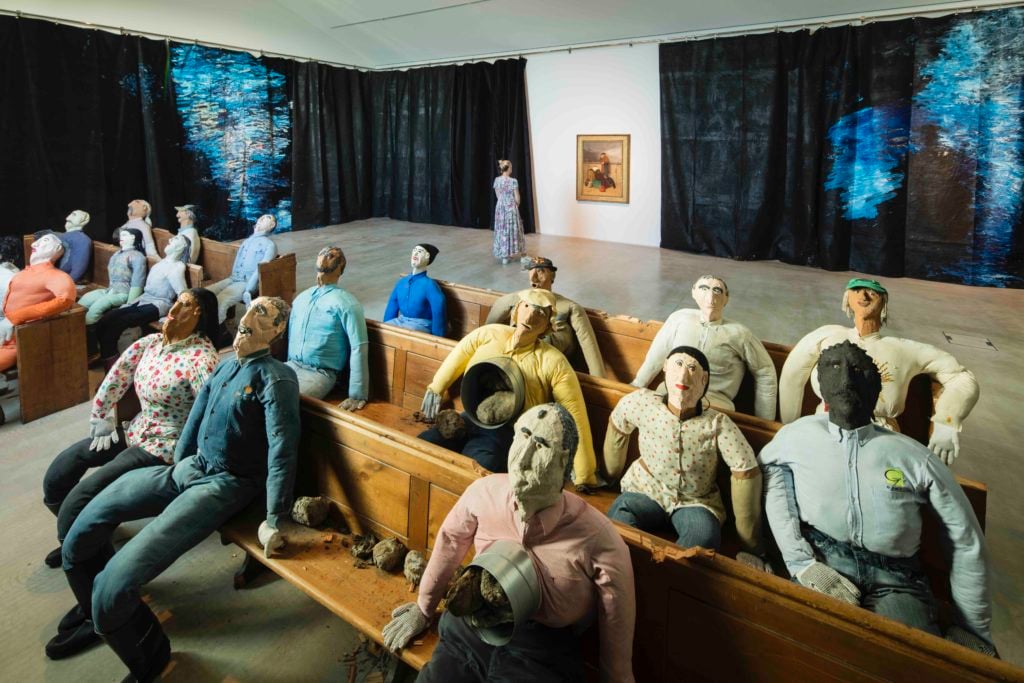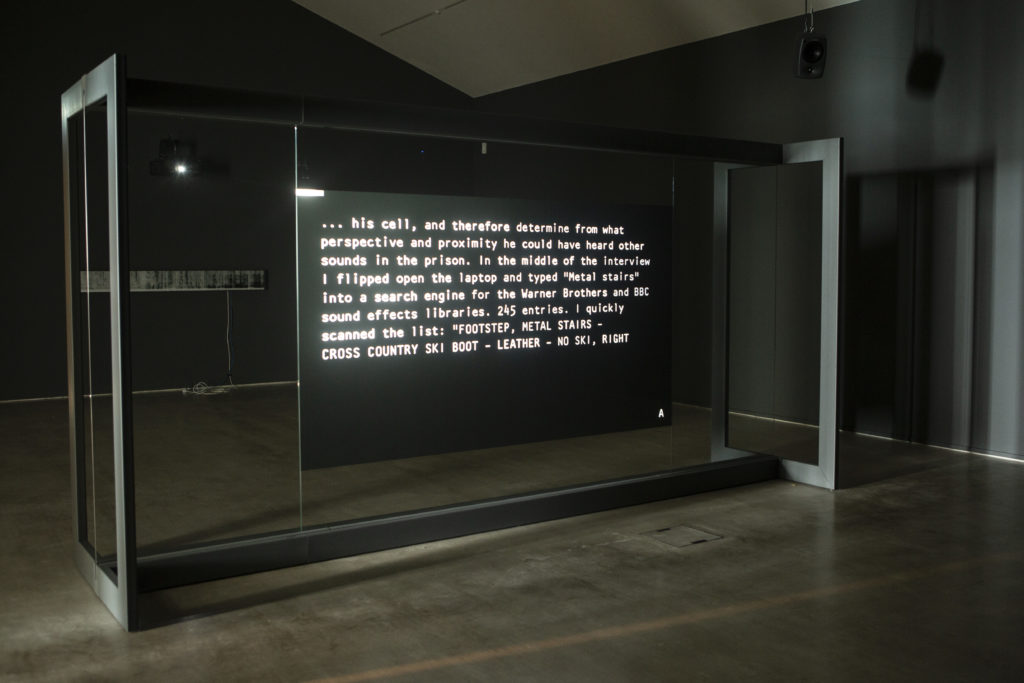On View
Who Are This Year’s Turner Prize Nominees? Meet the 4 Provocative Artists Shortlisted for the UK’s Most Prestigious Art Award
Meet Helen Cammock, Tai Shani, Oscar Murillo, and Lawrence Abu Hamdan.

Meet Helen Cammock, Tai Shani, Oscar Murillo, and Lawrence Abu Hamdan.

Naomi Rea

The Turner Prize exhibition officially opens to the public tomorrow, showcasing the output of this year’s crop of four nominees: Lawrence Abu Hamdan, Helen Cammock, Oscar Murillo, and Tai Shani.
The annual exhibition was established in 1984 to stimulate public conversation around contemporary art, and it seldom fails to meet the task. Last year’s five-hour video extravaganza raised the hackles of several members of the public, while the works of the YBAs in the 1990s, several of whom have been nominated for the prize, were notoriously provocative.
The annual prize exhibition is held at a venue outside of the capital city every other year, and this year it has decamped from London to Margate, the seaside hometown of one of the prize’s most famous nominees, Tracey Emin. The current exhibition will run through January 12, 2020, at Turner Contemporary—an apt setting given that the gallery is located on the site of a former lodging house where JMW Turner lived, in the town that inspired his deep fascination with the sky.
The prestigious award is given to an artist for an outstanding exhibition or other presentation of their work in the preceding year, with the winner receiving £25,000 ($31,000), and the three other shortlisted artists receiving £5,000 each ($6,000). This year’s prize will be judged by Alessio Antoniolli, director of Gasworks & Triangle Network; Elvira Dyangani Ose, director of The Showroom Gallery and lecturer in visual cultures at Goldsmiths; Victoria Pomery, director of Turner Contemporary, Margate, and Charlie Porter, a writer. The jury is chaired by Tate Britain director Alex Farquharson.
Before the winner is announced on December 3, at an award ceremony broadcast live on the BBC, get to know the four nominees with our breakdown, below.

Helen Cammock, video still from The Long Note (2018). Commissioned by VOID, Derry/Londonderry, Turner Prize 2019 at Turner Contemporary Margate. Photo by David Levene. Courtesy of the artist.
Born: 1970, Staffordshire, UK; based in London
Age: 48
Nominated for: Her solo exhibition “The Long Note” at Void, Derry/Londonderry and IMMA, Dublin
Best known for: Film work exploring social histories, based on deep research processes that uncover and raise up marginalized voices. Cammock also works in photography, print, text, and performance.
Work in the Turner show: A film installation of The Long Note (2018), a collage of archival footage, new film, and interviews conducted by Cammock. The work excavates the overshadowed role of women in the civil rights movement in Derry/Londonderry in 1968, the beginning of the Troubles in Northern Ireland. Cammock challenges the purportedly “objective” way histories are told and draws attention to her own subjectivity as an author by inserting herself into the film, appearing at times to clean rain off the camera lens or respond to an interviewee.
Interwoven with musical interludes, from traditional Irish songs to Nina Simone’s spellbinding 1976 performance of How It Feels to Be Free, the film, which runs an hour and 39 minutes, is on the face of it tightly focused, but the long note reverberating through it connects the struggles of women in Ireland to the black feminists fighting during the civil rights movement in the US to contemporary struggles involving gender, class, and race.
Five of Cammock’s hand-pulled screen prints from her 2017 series “Shouting in Whispers” are also on display, bearing texts that are important to her from the words of Trinidad-born activist Claudia Jones to her own poetry to a dictionary definition of the word “punctum.” Finally, Cammock provides a space for visitors to discuss and learn about the various different struggles for civil rights.
In their own words: “I want to disrupt the smooth, often linear understanding and reception of histories, to make us think about their construction. I am interested in exploring the interconnectedness of time periods and geographies, and the structural and personal intersectionality that is the cement of all experiences, and is for me the continuum of histories, which are both cyclical in form but also living and ever-evolving entities.”
Gallery affiliation: None
Notable detail: Cammock was a social worker for 10 years before she became an artist.
On view elsewhere: Cammock recently closed a show at the Whitechapel Gallery, and is preparing to embark on an artist residency at Wysing Arts Center in Cambridgeshire this fall.
Up next: “Che Si Può Fare (What Can be Done)” at Maramotti Collection, Reggio Emilia, Italy, October 13, 2019 – February 16, 2020; “Radio Ballads” a Serpentine Galleries project, November 20, 2019 – April 20, 2020; solo show at Wysing Arts Center, Cambridgeshire, February 20 – April 20, 2020; “Concrete Feathers and Porcelain Tacks,” Photographers Gallery, London, and Touchstones, Rochdale, June 20 – October 20, 2020

Tai Shani, DC: Semiramis (2019). Installation view of Turner Prize 2019 at Turner Contemporary. Photo by David Levene. Courtesy the artist and Turner Contemporary.
Born: 1976, London; based in London
Age: 43
Nominated for: Her participation in Glasgow International 2018, the solo exhibition “DC: Semiramis” at The Tetley, Leeds, and her participation in “Still I Rise: Feminisms, Gender, Resistance” at Nottingham Contemporary and the De Le Warr Pavilion, Bexhill-on-Sea
Best known for: The ongoing project Dark Continent, of which the Turner show is a part, inspired by a 15th-century protofeminist text, The Book of the City of Ladies by Christine de Pizan. Shani is creating her own city of women, through theatrical installations, performances, and films, featuring fantastical characters.
Work in the show: A bright pink architectural model of Shani’s “womxn’s city,” an imagined place that exists outside of patriarchy, complete with strange moons and udder-like appendages oozing resinous goo, and anchored around the large green hand of Semiramis, the legendary Assyrian queen.
The highly Instagrammable piece is scored by the British pop duo Let’s Eat Grandma and is accompanied by a narrator embodying the characters who populate a 12-episode epic through which Shani conveys her deeply detailed universe. Indebted to feminist science fiction as much as écriture féminine, gender theory, myths, and fantasies, Shani has created a surreal world that is at once an imaginary future and an alternate history. The narrator’s words are heard via wireless headphones, access to which is age-restricted due to the disturbing nature of some of the episodes, which deal with issues of trauma, abuse, and erotic taboos, although they are all available to read in an accompanying book. The theatrical installation will be further activated by performers on occasions throughout the run of the exhibition.
In their own words: “I wanted to create both a physical and a conceptual space to critique contemporary gender constructs, but also to imagine an alternative history which privileges sensation, experience, and interiority, undermining hegemonic conceptions of narrative history to propose these possible visions of post-patriarchal futures. It is world-making within which patriarchal ideology is replaced with marginalised ideologies, such as intersectional and queer feminism, to propose polyphonic, non-hierarchical perspectives on history, science and nature.”
Gallery affiliation: None
Notable detail: Shani grew up on a commune in Goa, and although she never received a university qualification in art, it has been omnipresent in her life, as she was raised by a progressive artistic family, her father a writer, her mother an actor and photographer.
On view elsewhere: “Tai Shani: Tragodía” at Moravská Galerie, Czech Republic, September 27 – December 8
Next up: DC: Semiramis (2019) will be part of a group show, “ALIAS” organized by Netwerk Aalst, Belgium, September 28 – December 1.

Oscar Murillo, installation in Turner Prize 2019 at Turner Contemporary, including surge (social cataracts) (2019), Collective Conscience (2019), The Institute of Reconciliation (2019), and John Watson Nicol’s Lochaber No More (1883). Photo by David Levene. Courtesy of the artist and Turner Contemporary.
Born: 1986, La Paila, Colombia; based in London and elsewhere
Age: 33
Nominated for: His participation in the 10th Berlin Biennale, his solo exhibition “Violent Amnesia” at Kettle’s Yard, Cambridge, and “Oscar Murillo/Zhang Enli” at the chi K11 art museum, Shanghai
Best known for: His restless and relentless production of paintings, through which he experiments with mark making on unstretched canvases, sometimes collaged together with recycled material. Murillo also makes drawing, performance, sculpture, and sound works, reflecting on his own experience of displacement (he moved to London from Colombia at age 11), and the social fallout of globalization.
Work in the show: In the gallery with Turner Contemporary’s best view out to the North Sea, a series of hacked-up pews house papier-maché effigies inspired by a Colombian New Year tradition. The fragile bodies from Murillo’s ongoing “collective conscience” series represent the global mobile workforce, pipes ripped into their stomachs reflecting the insidious violence of capitalism. The figures were accompanied on the train and wheeled along the seafront to the gallery in a performative action. They sit waiting, facing the window, which is mostly obscured by swaths of black canvas, part of his series “The Institute of Reconciliation.” The black canvas extends to walls around the room, where it is flooded in patches with blue paint, part of the artist’s “surge (social cataracts)” series, a reference to Monet’s eye problems, and the social blindness of the current moment. Over the course of the exhibition, a performer will also read from the Brazilian author Patricia Galvão’s 1933 novel Industrial Park: A Proletarian Novel.
In the back of the gallery hangs a 19th-century painting by John Watson Nichol, Lochaber No More (1883). The painting of Scottish migrants shipping off to America during the Highland Clearances serves as a poignant reminder that migration is a part of the history of the UK, and more broadly of humanity.
Not visible in the exhibition, but a part of it all the same, is a new extension of Murillo’s collaboration between his family and political scientist Clara Dublanc, the “Frequencies” project. Schools around Kent are receiving canvases to be fixed to school desks for six months, with students invited to make whatever marks they want, offering up a sort of analogue record of a particular time.
In their own words: “I am seeing my participation in Turner Prize 2019 as an opportunity, particularly given that the exhibition is in Margate this year, to think about my practice in relation to the UK, its culture, its history and where society finds itself currently, from a social, geographical and economic point of view, and this is what draws me to this space. The beautiful view was the most attractive thing, but it can also be an opportunity to negate such a view, almost to make clear the darkness or ignorance of the moment.”
Gallery affiliation: David Zwirner, Carlos/Ishikawa, Isabelle Bortolozzi Galerie
Notable detail: Oscar Murillo is the only bona fide market star included in this year’s crop of Turner Nominees. At his most recent exhibition with David Zwirner, “Manifestation” works were on sale for $320,000-$400,000. His work has come to auction 133 times, and his auction record is $401,000 (with premium) achieved at Phillips New York in 2013 for an untitled canvas from 2011 from his “drawings off the wall” series.
On view elsewhere: “trades hall & institute” at Carlos/Ishikawa London through October 19; “Oscar Murillo: Frequencies” at Yorkshire Sculpture Park, through November 3; “Grand Hotel Abyss” at Steirischer Herbst Festival, Graz and Styria, Austria through October 13; “HERE AND NOW: Transcorporealities” at Museum Ludwig, Cologne, Germany through January 19, 2020
Up Next: “Oscar Murillo: Horizontal Darkness In Search of Solidarity” at the Kunstverein in Hamburg, Germany, November 8, 2019 – January 26, 2020. “Oscar Murillo: Social Altitude” at the Aspen Art Museum, November 23, 2019 – May 17, 2020

Lawrence Abu Hamdan, After SFX (2018). Turner Prize 2019 at Turner Contemporary, Margate 2019. Photo by Stuart Leech. Courtesy the artist.
Born: 1985 in Amman, Jordan; based in Beirut.
Age: 34
Nominated for: His solo exhibition “Earwitness Theatre“ at Chisenhale Gallery, London, and for the video installation Walled Unwalled and performance After SFX at Tate Modern, London. Both projects came from ear-witness interviews with six former detainees of the Syrian Regime prison Saydnaya, who were subjected to total sensory deprivation during their incarceration, as part of an audio investigation by Amnesty International and Forensic Architecture to map the unknown architecture of the prison and to understand what happened there.
Best known for: Abu Hamdan calls himself a “private ear” because he investigates crimes that have been heard and not seen. Abu Hamdan reconstructs contested situations and events through sound, creating audiovisual installations, lecture performances, audio archives, photography, and text.
Work in the show: Three works are installed in the space and shown on a loop: Saydnaya (the missing 19db) (2017), a light-box visualization of the decrease in volume of the inmates’ voices after the Syrian revolution, when the prison became a death camp where speaking was a capital offense. Walled/Unwalled, recorded in an East Berlin recording studio, a spoken-word interlacing of different court cases that relied on ear-witness testimony, from the trial of Oscar Pistorius to that of OJ Simpson, anchored around the Saydnaya prisoners’ relation of the walls of their cells as solid and yet sound-permeable structures. After SFX, a text animation accompanied by sound effects from 95 custom-designed sound objects meant to correspond to the sounds the prisoners described hearing from their cells, as well as other cases that relied on contested sonic testimony.
In their own words: “The works are intended to serve a double purpose: both to reflect and transmit the stories of that prison in the way I believe more adequately suits the entanglements of place and sensory experience, and to argue for art as a mode of truth production that is distinct from the way science and the law derive their truths. I believe it is just as valid a strategy for producing claims and documenting events as the fields which we conventionally task to do this.”
Gallery affiliation: Maureen Paley, Mor-Charpentier, Sfeir-Semler.
Notable detail: Abu Hamdan is also affiliated with Forensic Architecture, the collective shortlisted for the Turner Prize last year.
On view elsewhere: “May You Live in Interesting Times,” the 58th Venice Biennale, Italy through November 24; “Crack Up – Crack Down,” the Ljubljana Biennial of Graphic Arts, Slovenia, through September 29; “Lawrence Abu Hamdan” at Sfeir-Semler Gallery, through January 4, 2020; “Eavesdropping” at City Gallery Wellington, New Zealand, through November 17.
Up next: The Shouting Valley: Interrogating the Borders Between Us” at Gus Fischer Gallery, Auckland, New Zealand, September 28 – December 14; “Nirin” Biennale of Sydney, Australia, March 14 – June 18, 2020
The Turner Prize Exhibition is on view September 28, 2019, to January 12, 2020, at Turner Contemporary in Margate.